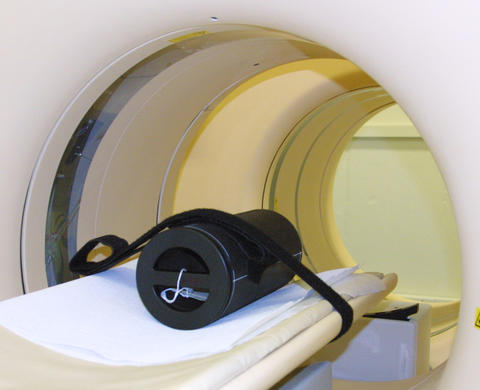
NIST has developed a technique to calibrate the "phantoms" that provide a daily benchmark for PET scanner sensitivity. The resulting phantoms will be the first ones commercially available for PET that can trace calibration directly to NIST standards.
Teaming with a medical equipment company, researchers at the National Institute of Standards and Technology (NIST) have demonstrated the first calibration system for positron emission tomography (PET) scanners directly tied to national measurement standards. Better calibrations of the machines potentially can increase the accuracy of their diagnostic images by several times, according to NIST scientists.
The new calibration capability can be used to fine-tune PET scanners that find cancers and track the progress of treatments, among other diagnostic applications. It will be used to ensure the accuracy of some of the newest scanners on the market.
NIST's technique, developed over the past few years, is used to calibrate devices called "phantoms," built specifically for PET scanners. Phantoms are commonly used to check medical imaging devices such as X-ray scanners. Typically, they are simply blocks of materials known to respond to—for example—X-rays in a consistent, known manner that's similar to the way human tissues respond. PET phantoms are more complicated because the scanners work by detecting radioactive materials injected in the patient.
The PET phantoms are lightweight hollow cylinders about the size of a two-liter soda bottle. They contain a small amount of radioactive germanium, which glows brightly in a PET scanner's readout. Measuring its brightness each day provides a benchmark for scanner sensitivity that allows medical technicians to compare patient scans taken on different days more effectively.
The phantoms will be the first ones commercially available for PET that can trace calibration directly to NIST standards. The NIST team's method measures the phantom's germanium content directly, eliminating some known sources of error. The phantoms are designed specifically for scanners that combine PET and magnetic resonance imaging (MRI). PET and MRI are potentially an ideal combination for diagnosis because PET reveals spots where cancer likely exists, and MRI provides the basic picture of a patient's body so the PET scan can be oriented precisely. (This basic picture is usually provided by X-ray computed tomography, also known as a CAT [computerized axial tomography] scan, but MRI does not use radiation, while CAT does.)
NIST developed the calibration method partly in response to a request by Sanders Medical Products, which supplies the phantoms to GE Healthcare, a manufacturer of combination PET-MRI scanners. A Sanders phantom will ship with every new scanner of this type that GE builds. Brian Zimmerman, part of the NIST group that developed the method, says that the team is working on calibrating two more commercial phantom designs for Sanders that will be used with other types of clinical PET scanners. Together, the increased availability of NIST measurement traceability for clinical use could help save time and money for patients as well as drug companies, he says.
"Doctors are realizing putting effort into this kind of quantitative work can reveal differences of 5 percent in tumor size, rather than the 20 percent they look for now," Zimmerman says. "It might help them to make decisions more quickly concerning whether a treatment or a clinical trial is working out."

